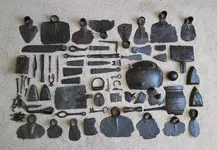Steve - yes, there are several design attributes to help date hoes which will be discussed in my book. But basically the style of hoe can help with general dating as the narrow (or grubbing hoes) tend to be 17th to early 18th century, and the broad hoes are found mostly on 18th century sites. Also, earlier hoes dating back to the 1600s often have open, V-shaped cutouts in the front of their collars and longer necks while pronounced spines and closed collars are commonly featured on 18[SUP]th[/SUP] century examples. There's an excellent publication entitled "Colonial Plantation Hoes of Tidewater Virginia" by Keith Egloff that can be purchased for about $10 that will tell you everything you need to know about hoes, and is a great addition to an colonial enthusiast's reference library.






